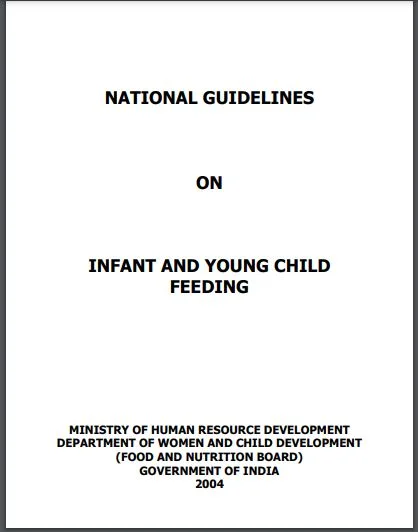‘Infant and Young Child Feeding Guidelines’ PDF Quick download link is given at the bottom of this article. You can see the PDF demo, size of the PDF, page numbers, and direct download Free PDF of ‘Infant and Young Child Feeding’ using the download button.
Infant And Young Child Feeding Guidelines 2016 PDF Free Download

Infant and Young Child Feeding
Infant and young child nutrition has been engaging the attention of scientists and planners since long for the very simple reason that growth rate in the life of human beings is maximum during the first year of life and infant feeding practices comprising of both the breastfeeding as well as complementary feeding have major role in determining the nutritional status of the child.
The link between malnutrition and infant feeding has been well established. Recent scientific evidence reveals that malnutrition has been responsible, directly or indirectly, for 60% of all deaths among children under five years annually.
Over 2/3 of these deaths are often associated with inappropriate feeding practices and occur during the first year of life.
Only 35% of infants world-wide are exclusively breastfed during the first four months of life and complementary feeding begins either too early or too late with foods which are often nutritionally inadequate and unsafe.
Poor feeding practices in infancy and early childhood, resulting in malnutrition, contribute to impaired cognitive and social development, poor school performance and reduced productivity in later life.
Poor feeding practices are, therefore, a major threat to social and economic development as they are among the most serious obstacles to attaining and maintaining health of this important age group.
Optimal Infant and Young Child Feeding practices – especially early initiation and exclusive breastfeeding for the first six months of life – help ensure young children the best possible start to life.
Breastfeeding is nature’s way of nurturing the child, creating a strong bond between the mother and the child.
It provides development and learning opportunities to the infant, stimulating all five senses of the child sight, smell, hearing, taste, touch.
Breastfeeding fosters emotional security and affection, with a lifelong impact on psychosocial development.
Special fatty acids in breast milk lead to increased intelligence quotients (IQs) and better visual acuity.
A breastfed baby is likely to have an IQ of around 8 points higher than a non-breastfed baby.
Breastfeeding is not only important for young child survival, health, nutrition, the development of the baby’s trust and sense of security – but it also enhances brain development and learning readiness as well.
The sound practice of breastfeeding suffered a set back because of aggressive media campaign of the multinational companies producing baby milk powder and infant foods.
The WHO in late 70s recognised the seriousness of the declining trend in breastfeeding and introduced an International Code for Protection and Promotion of Breastfeeding in 1981.
The Indian Government adopted a National Code for Protection and Promotion of Breastfeeding in 1983.
The Infant Milk Substitutes, Feeding Bottles and Infant Foods (Regulation of Production, Supply and Distribution) Act 1992, is being implemented by the Department of Women and Child Development since 1993.
As per the scientific evidence available at that time, an age range of 4-6 months for exclusive breastfeeding of young infants was included in the international as well as national code.
The age range was misused by the multinational companies which started promoting their products from the third month onwards. The early introduction of complementary foods was resulting in infections and malnutrition.
The National Nutrition Policy adopted by the Government of India under the aegis of the Department of Women and Child Development in 1993 laid due emphasis on nutrition and health education of mothers on infant and young child feeding and efforts to trigger appropriate behavioural changes among the mothers were considered as direct interventions for reducing malnutrition in children.
The Government of India has always been promoting at the national and international fora exclusive breastfeeding for the first six months and introduction of complementary foods thereafter with continued breastfeeding upto two years which is consistent with the Indian tradition of prolonged breastfeeding and introduction of complementary foods from six months of age through an annaprashan ceremony.
Various research studies since early 90s have brought out the beneficial effects of exclusive breastfeeding for the first six months on the growth, development and nutrition and health status of the infant and also for the mother.
It was revealed that exclusive breastfeeding not only prevented infections particularly the diarrhoeal infections in the child but also helped in preventing anaemia in child as breast milk has the best bioavailable iron.
The appearance of enzyme amylase in the seventh month of the infant was suggestive of desirability of introducing cereal based foods in the diet of infant after the age of six months.
Early initiation of breastfeeding lowers the mother’s risk for excess post-partum bleeding and anaemia.
Exclusive breastfeeding boosts mother’s immune system, delays next pregnancy and reduces the insulin needs of diabetic mothers.
Breastfeeding can help protect a mother from breast and ovarian cancers and osteoporosis (brittle bones).
While the scientific community was making efforts to adopt six months as the duration of the exclusive breastfeeding, the commercial influence particularly from the West was resisting this move at international fora namely Codex Committee on Nutrition and Foods for Special Dietary Uses, Codex Alimentarius Commission and the World Health Assembly.
However, with the persistent efforts of the Department of Women and Child Development with active cooperation of the Department of Health, a landmark decision was taken in the World Health Assembly in May 2001 and Resolution 54.2 made a global recommendation for promoting exclusive breastfeeding for the first six months, introduction of complementary foods thereafter with continued breastfeeding upto the age of two years and beyond.
Further, a new Resolution on Infant and Young Child Nutrition (WHA 55.25) was adopted by the 55th World Health Assembly in May 2002.
The resolution endorses a Global Strategy on Infant and Young Child Feeding.
The 55th World Health Assembly recognises that inappropriate feeding practices and their consequences are major obstacles to sustainable socio-economic development and poverty reduction.
It also states that Governments will be unsuccessful in their efforts to accelerate economic development in any significant long term sense until optimal child growth and development, specially through appropriate feeding practices, are ensured.
The global strategy gives due weightage to mother and child dyad and advocates that improved infant and young child feeding begins with ensuring the health and nutritional status of women, in their own right, throughout all stages of life.
The persistent efforts of the Department of Women and Child Development helped in enacting the Infant Milk Substitutes, Feeding Bottles and Infant Foods (Regulation of Production, Supply and Distribution) Amendment Act, 2003 which came into action from 1 January 2004.
The important amendments in the act relate to extending the age of exclusive breastfeeding from 4-6 months to 6 months and bringing infant foods at par with infant milk substitutes in so far as advertising, promotion and other regulations are concerned.
India now has one of the strongest legislation to protect breastfeeding from commercial influence.
| Language | English |
| No. of Pages | 26 |
| PDF Size | 0.5 MB |
| Category | Health |
| Source/Credits | wcd.nic.in |
Infant and Young Child Feeding Guidelines PDF Free Download
